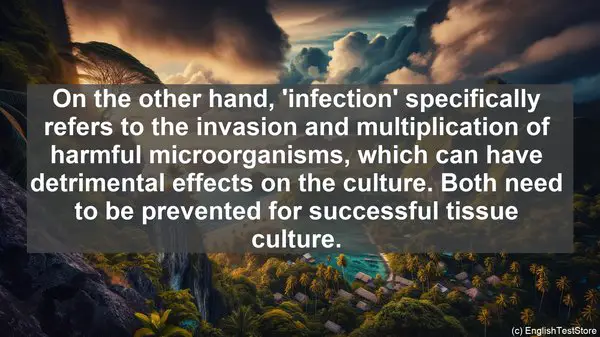Introduction
Welcome to today’s lesson on tissue culture. In this lesson, we’ll be focusing on the top 10 commonly confused words in this field. Understanding these words correctly is crucial for accurate communication and successful experiments. So, let’s dive right in!
1. Sterile vs. Aseptic
The terms ‘sterile’ and ‘aseptic’ are often used interchangeably, but they have distinct meanings. ‘Sterile’ refers to the complete absence of any living organism, while ‘aseptic’ means the prevention of contamination by harmful microorganisms. So, while a sterile environment is always aseptic, the reverse may not be true.
2. Medium vs. Media
When referring to the nutrient solution used in tissue culture, the correct term is ‘medium,’ not ‘media.’ ‘Media’ is the plural form of ‘medium’ and should only be used when referring to multiple types of nutrient solutions.
3. Explant vs. Inoculum
In tissue culture, an ‘explant’ refers to a piece of tissue or organ that is taken from a plant or animal and used to initiate a culture. On the other hand, ‘inoculum’ is the term used for the material, such as cells or microorganisms, that is introduced into a culture. While both are used to start a culture, they are different in their origin and composition.

4. Callus vs. Callous
The words ‘callus’ and ‘callous’ may sound similar, but they have different meanings. In tissue culture, a ‘callus’ is an unorganized mass of cells that forms on a culture medium. On the other hand, ‘callous’ refers to a hardened or thickened area of tissue. So, when discussing tissue culture, it’s important to use the correct term, ‘callus.’
5. Proliferation vs. Differentiation
In tissue culture, ‘proliferation’ and ‘differentiation’ are two key processes. ‘Proliferation’ refers to the rapid increase in the number of cells, while ‘differentiation’ is the process by which cells become specialized and take on specific functions. Both processes are essential for the successful growth and development of tissues in culture.

6. Explantation vs. Transplantation
While both terms involve the movement of tissue, ‘explantation’ and ‘transplantation’ are different. ‘Explantation’ refers to the removal of tissue from its original location for the purpose of culture, while ‘transplantation’ is the transfer of tissue from one organism to another. So, when discussing tissue culture, it’s important to use the correct term based on the context.
7. Subculture vs. Passage
In tissue culture, ‘subculture’ and ‘passage’ are often used interchangeably. Both terms refer to the transfer of cells or tissues from one culture vessel to another. However, ‘passage’ is a more general term that can encompass various methods of transfer, while ‘subculture’ specifically refers to the transfer of a portion of a culture to a new vessel.
8. Contamination vs. Infection
In tissue culture, ‘contamination’ and ‘infection’ are two concerns. ‘Contamination’ refers to the presence of unwanted microorganisms, such as bacteria or fungi, in a culture. On the other hand, ‘infection’ specifically refers to the invasion and multiplication of harmful microorganisms, which can have detrimental effects on the culture. Both need to be prevented for successful tissue culture.
9. Lysis vs. Necrosis
When cells in a culture die, it’s important to understand the cause. ‘Lysis’ refers to the breaking down of cells, often due to factors like osmotic imbalances. ‘Necrosis,’ on the other hand, is cell death caused by factors like injury or lack of nutrients. Understanding the cause of cell death can help in troubleshooting and improving culture conditions.
10. Cryopreservation vs. Lyophilization
In tissue culture, two common methods of long-term storage are ‘cryopreservation’ and ‘lyophilization.’ ‘Cryopreservation’ involves freezing the cells or tissues at extremely low temperatures, while ‘lyophilization’ is a process of freeze-drying, where the water is removed from the sample. Both methods can help in preserving cultures for future use, but they have different applications and requirements.
